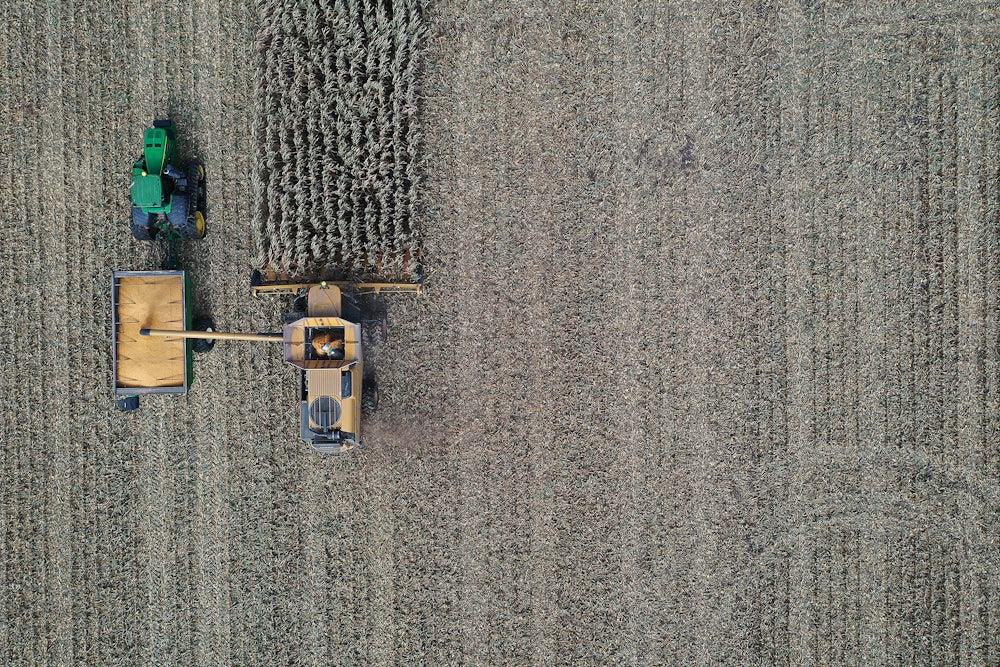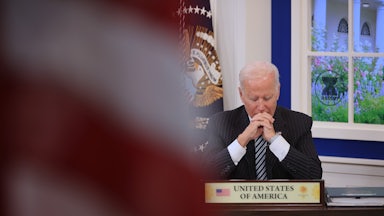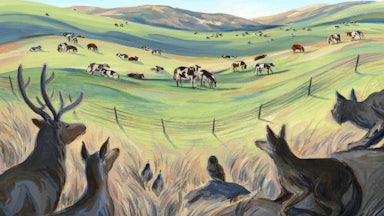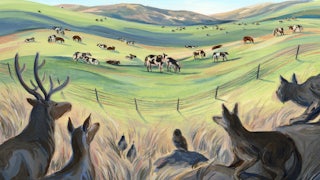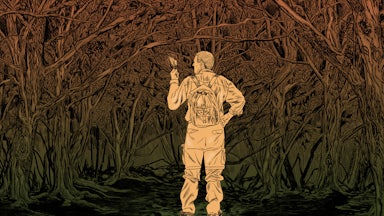In late April of 2020, many Americans were shocked by the Trump administration’s executive order to keep the nation’s meatpacking plants humming: Covid-19 was tearing through the plants where workers labored, crammed shoulder to shoulder, sickening them and helping to spread the virus in their communities. The companies who owned the plants publicly insisted that shuttering plants would spark a meat shortage and imperil the country’s food supply. Behind the scenes, they used their access with U.S. Department of Agriculture Secretary Sonny Perdue to shape the executive order and USDA policy, keeping a steady supply of meat flowing to both American supermarkets and lucrative foreign markets. Over the next year, meatpacking plants would lead to 334,000 Covid-19 infections. The mere presence of a beef or pork plant in a community, according to one study, doubled the community’s infection rate.
It’s easy to dismiss this sad saga as another example of malfeasance and mismanagement by the Trump administration. But the truth is that Big Meat has just as much pull with Joe Biden’s USDA. Current Agriculture Secretary Tom Vilsack previously served as the head of the USDA during both of Obama’s terms. Then, after enthusiastically handing the baton to Perdue, he sauntered through the revolving door into the CEO position at the U.S. Dairy Export Council before promptly trotting back to his old cabinet seat with the Democratic victory. At the recent COP26 climate summit, despite the fact that animal agriculture contributes 15 percent of global greenhouse gas emissions, he told reporters, “I do not think we have to reduce the amount of meat or livestock produced in the U.S.” This is just one example of the department’s support for a dysfunctional status quo. Since the start of Joe Biden’s term, the USDA has supported increasing already back-breaking line speeds at slaughterhouses, failed to address racial disparity in loans and grants, and, instead of working to actually reduce American agriculture’s climate footprint, backed bandaid-technofixes like methane bio digesters on factory farms and agricultural carbon offsets.
The USDA, at this point, is so thoroughly captured by big agribusiness that it barely matters which party picks the secretary; whoever serves will ultimately serve mega-corporations and rich farmers. That’s partly because our political system over-represents rural voters and monied interests. But it’s also the product of more banal dysfunctions: poor institutional design, inertia, and mission-drift at an agency built for a different country and a different time.
The USDA was designed for a United States in which a majority of people made their livelihoods, directly or indirectly, from agriculture. That country is long gone. It is replaced by one where very few people—and very few, very large corporations—control food production and distribution to the detriment of American consumers, taxpayers, and workers. If we are to have any hope of fixing what ails the American food system, we need a drastic approach: We need to abolish the USDA. In its place, we need an institution that will prioritize the public interest, including the interests of laborers and eaters, as well as public health and the environment. We need a Department of Food.
To understand why the USDA is so ill-suited for the present moment, you have to understand its current structure. With a budget of $146 billion and about 100,000 employees, the USDA is a mammoth agency. It runs three different forms of direct assistance to farmers: commodity support programs, crop insurance, and “conservation” funding, which pays farmers to keep fields fallow or to implement emissions-mitigation programs on their farms. Off the farm, the USDA administers forests through the Forest Service, food safety regulation and oversight through the Food Safety and Inspection Service, rural development initiatives like high-speed broadband through the Rural Utilities Service, agribusiness research and development both directly and through grants, and the promotion and sale of U.S. agricultural commodities in foreign markets. It also administers the Supplemental Nutrition Assistance Program (formerly the Food Stamp Program, now known as “SNAP”) and other nutrition programs, which together make up just under 80 percent of the agency’s budget. All of this is funded through the sprawling Farm Bills that substantively define U.S. agricultural policy and the USDA’s operations every five years.
/ In honor of Earth Day, Apocalypse Soon content is free to registered users until April 29. Start reading now.
There are two big problems here. On the one hand, the USDA is charged with the oxymoronic double mandate of both promoting and regulating all of American agriculture—two disparate tasks that, when combined, effectively put the fox in charge of the henhouse. On the other hand, the department remains focused on the needs of agricultural producers despite the broad social, environmental, and economic impacts of agriculture. In practice, this means that the USDA’s budget and policies must satisfy large farming interests, who demand and often get something in exchange for agreeing to the USDA’s other policies.
These policies also show up in the administration and funding of SNAP, the nation’s biggest—if imperfect—policy solution to food insecurity. Through the Farm Bill, funding for SNAP has been fused to the USDA’s subsidy programs since its creation in the 1960s. As a result, the food security of the nation’s poorest households is continually held ransom to agricultural subsidies; any efforts by progressives to pare those subsidies will be met with cuts or roadblocks to food assistance by farm state politicians. And attempts to improve SNAP similarly run into partisan politics.
Meanwhile, all those subsidies flow to farm households that hold a total net wealth nine times greater than the national median and, even among that already wealthy demographic, overwhelmingly to the very wealthiest farmers. Worse still, subsidies can increase the cost of food by incentivizing the production of nonfood commodities such as corn for ethanol and distorting agricultural markets. The marriage of SNAP and commodity support programs isn’t just bad; it’s perverse. There is no reason why food aid to the poorest Americans should be tied to support for the production of cash crops.
SNAP is the most flagrant example, but it’s hardly alone. Because the USDA administers important parts of trade, energy, labor, and sometimes even military policy, these all appear in the Farm Bill. That means that farm-state politicians (who write the legislation) and big agricultural interests (whom they serve) use their outsized leverage to shape important policies otherwise unrelated to agriculture. This results in the sorts of massive subsidies and bailouts that prop up mass-scale commodity production. In 2019, for instance, when the Trump administration sought to compensate corn farmers for losses caused by its trade disputes, it overpaid $3 billion in aid to corn farmers, including offering farmers in different regions different prices for corn, with premiums going to those in the South and Midwest. The USDA also regularly provides price supports and bailouts for industries like dairy, with one study suggesting that dairy farms receive upwards of 75 percent of their revenue from different government supports.
This horsetrading ultimately distorts and undermines any laudable project progressive forces might try to run through the department. For example, subsidies for corn ethanol ensure the crop is a reliable moneymaker for Midwestern farmers, but its contribution to a sustainable energy policy, its stated raison d’etre, is at best neutral.
The throughline of all this dysfunction is simply that the USDA puts the interests of agricultural production for its own sake over everything else. As a result, the countless systemic problems of modern American agriculture go unaddressed. Agricultural workers are among the worst-paid in the United States, their wages completely incommensurate with the difficult and dangerous work they perform. A conservative estimate is that agriculture makes up 10 percent of all U.S. greenhouse gas emissions. It is also one of the biggest polluters of waterways in the U.S. Small, alternative, and minority-owned farming gets scant support. Meanwhile, over 100 million Americans are obese or suffer from diet-related diseases like diabetes and hypertension, in part as a result of agricultural policies and in part due to the failure of public health policies.
Under the USDA’s watch, American farming has become the consummate exception to countless regulatory reforms of the past century. The law forbids you from treating animals in a cruel fashion. . . unless you’re a farmer. The law forbids you from dumping debris into open waterways. . . unless you’re a farmer. The law forbids you from firing an employee for joining a union. . . unless you’re a farmer. And the law also forbids you from employing a child under the age of 14. . . unless you’re a farmer. This last exception was so outrageous that Obama’s Department of Labor attempted to close the loophole in 2012 by extending the protection of existing child labor laws to agriculture. The changes were met with criticism from predictable corners such as major agribusiness interests and farm state politicians, including Democrats Jon Tester and Al Franken. Joining the critics was none other than Tom Vilsack. The changes were scrapped. Upwards of 500,000 children still labor in American agriculture.
The USDA was established under Abraham Lincoln in 1862 as part of a suite of policies pushed by the small Northern farmers who made up the base of Lincoln’s Republican Party. In addition to the Homestead Act and the transcontinental railroad, these policies subsidized and accelerated the conversion of Western grasslands into settled agriculture and gave federal backing to the Jeffersonian ideal of small, independent, yeoman farmers—all, of course, on the plundered lands of Indigenous peoples, and doing little for the recently emancipated enslaved people who were excluded from many of the benefits.
This basic logic of serving landowners and producers hasn’t changed substantially even as the country and its agriculture have. In the 1860s, Lincoln had good reason to call the USDA “The People’s Department” since 50 percent of the population lived or worked on farms, and in a country of 31 million there were 1.5 million farms. By the 1930s, this idea still held as the population grew to almost 130 million with 6.8 million farms. Today, however, in a country of 330 million, there are only around 2 million farms, and of those the 5 percent largest operations make up almost 60 percent of all production. Farm workers and operators, meanwhile, make up about only 1.7 percent of the U.S. labor force, even as agricultural output is higher than ever.
Agriculture is now a high-volume and highly capitalized industry where a tiny fraction of farms produce the vast bulk of commodities. USDA policies are a big reason why. By trying, as MIT Professor Deborah Fitzgerald puts it, to turn “every farm into a factory,” the USDA pushed mechanical implements, artificial fertilizers, pesticides, and debt-financed, capital- and input-intensive agriculture. Given these incentives, most farmers, whether to grow rich or merely survive, have turned to business models predicated on high-yield monocropping, economies of scale, and farm consolidation. That means fewer, substantially larger farms produce just a handful of commodities or factory-farmed animals. Today, corn, soy, and wheat make up half of all crop sales, and upward of 99 percent of meat, including over 9 billion chickens, comes from factory farms where animals are fattened up on those crops.
This isn’t a pattern either major political party knows how to break: It’s built into the department’s structure and backed by a powerful lobbying apparatus. Farmers and agribusiness furnish the USDA with political capital and the USDA guarantees stable prices for commodity monocrops with minimal regulation. “Conventional farmers,” writes the agricultural critic Daniel Imhoff, “stay afloat by farming the system rather than growing what might best serve their particular tract of land for the long term or provide for more well-rounded, healthy diets.” The system serves up the safe bet, but it has also selected, generation after generation, for farmers (and policymakers) who only make safe bets.
While the USDA’s rotten policies work far better for large farmers than small ones, the primary victims are not people who own farms, but the 99 percent of the population who do not. Now more than ever, workers and consumers desperately need a safe, equitable, and sustainable food system, and to build one we need an agency up to the task.
A Department of Food would start with a mandate to maintain a just, healthy, and sustainable food system. Agricultural policy would be only one element, alongside food and nutritional access and industrial, energy, labor, land use, environmental, climate, and animal-welfare policies. It would leave the economic promotion of agriculture to the Department of Commerce and the production of energy to the Department of Energy, shedding its conflicts of interests and focusing its institutional energies exclusively on making sure that all Americans have access to safe, healthy, fairly produced, and affordable food. These goals would be its benchmarks of success—not the economic profitability of American agriculture as it is defined by rich farmers and agribusinesses executives.
With a clearer mission, the Department of Food would be leaner and more focused, armed with renewed energy and a broader public interest. It could stop subsidizing the production of corn ethanol. It could, instead, shape agricultural subsidies to incentivize the production of healthy foods that have low greenhouse gas and environmental footprints. It could start taxing the production of foods that do not.
The Department of Food could end agriculture’s regulatory exceptionalism by forcing farms to adhere to the same basic environmental, animal welfare, and labor standards that other businesses must already obey. It could ensure that all workers, on farms and in food services, are fairly paid, work under safe conditions, have robust labor rights, and have healthy and affordable food to eat. It could also leave all food-safety policymaking and oversight to the Food and Drug Administration, again eliminating a conflict of interest. (Currently, the USDA receives pressure from special interests, like meatpackers, whose products it promotes. As a result, the department winds up rubber-stamping misleading claims about the humane treatment of animals, for example.) The Department of Food could support major improvements in animal welfare laws, making the sort of treatment that is standard on factory farms illegal and industrialized animal agriculture functionally impossible, and with it the wasteful monocrop corn and soy animal feed supply chain.
The Department of Food could administer food assistance according to the nutritional needs of the population, not to manage agricultural surpluses, and it would work with other agencies to address the income inequality that drives food insecurity.
The Department of Food could make robust public investments in solutions to food systems problems outside the USDA’s obsessive focus on corn, soy, and meat. It could, for example, create a National Laboratory for Food Technology to conduct open-access, public-interest-based research on alternative proteins and improved processing, storage, and upcycling techniques. For farmers genuinely interested in sustainably producing fresh and healthy food for their communities, it could purchase acreage retired from commodity soy and corn or ranching production and found a national land bank. That bank could sell and finance at favorable terms to support tribal land-back schemes, reparations for communities historically excluded from farming, agro-ecological farming projects, rewilding and conservation initiatives, worker-owned farms, and community-supported agriculture.
All of this might seem radical, but it has solid precedents. Both Democratic and Republican politicians have from time to time suggested scrapping the USDA in favor of a more sustainable system. Richard Nixon proposed abolishing it in 1971. Jimmy Carter supported assigning most of its functions to other agencies in 1977. Orville Freeman, the Secretary of Agriculture in the Kennedy and Johnson administrations, hoped to signal a new approach when he called for renaming it the Department of Food and Agriculture or Department of Food and Rural Services. None of these efforts succeeded. But a major reorganization of the agency’s purpose already succeeded once when, during World War II, the Department of Agriculture was reorganized to meet the nation’s wartime needs.
To ensure that the nation’s agricultural and food policy supported the war effort, rather than suborned it, President Roosevelt created a new agency by executive order, called the War Food Administration, in 1943. It coordinated both the production and consumption of food, a task that required that it absorb most of the USDA’s functions and assume broad regulatory and pricing powers at every stage of the food system. Its charge was to meet production quotas based on the caloric needs of America’s fighting and laboring population, food supplies for its allies, and the raw materials for the war effort. Farmers did very well during World War II, but their interests were subordinated to the larger war effort as one of the many groups relevant to food policy.
We don’t need to treat the reorganization of the American food system as a war effort or use the all-too-American language of war to recognize the wisdom in Roosevelt’s approach. Roosevelt’s war powers allowed him to reorganize the USDA through an executive order. Change today would require an Act of Congress. That’s a tall order, and one certain to be opposed by anyone with a stake in the agricultural or political status quo. But consumers and workers—in both cities and the country, in both red and blue states—would benefit, as would small farmers, animals, and the environment—and the reality is that our food system demands it. An agency laser-focused on the interests of agribusinesses is as out of place in today’s world as it was in the midst of World War II.
